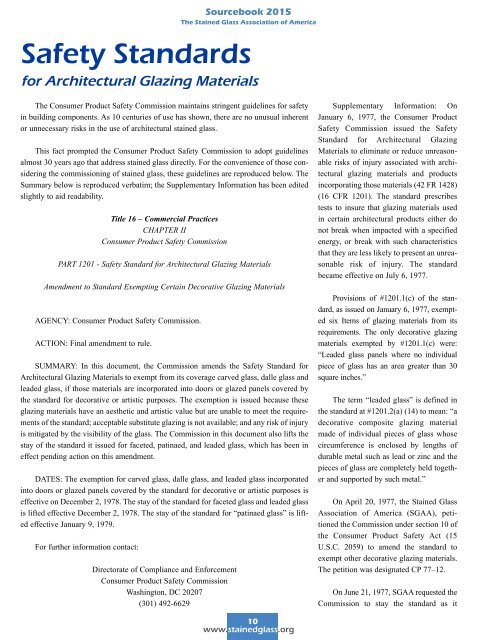Sourcebook 2015
Sourcebook-2015OE
Sourcebook-2015OE
- No tags were found...
You also want an ePaper? Increase the reach of your titles
YUMPU automatically turns print PDFs into web optimized ePapers that Google loves.
<strong>Sourcebook</strong> <strong>2015</strong><br />
The Stained Glass Association of America<br />
Safety Standards<br />
for Architectural Glazing Materials<br />
The Consumer Product Safety Commission maintains stringent guidelines for safety<br />
in building components. As 10 centuries of use has shown, there are no unusual inherent<br />
or unnecessary risks in the use of architectural stained glass.<br />
This fact prompted the Consumer Product Safety Commission to adopt guidelines<br />
almost 30 years ago that address stained glass directly. For the convenience of those considering<br />
the commissioning of stained glass, these guidelines are reproduced below. The<br />
Summary below is reproduced verbatim; the Supplementary Information has been edited<br />
slightly to aid readability.<br />
Title 16 – Commercial Practices<br />
CHAPTER II<br />
Consumer Product Safety Commission<br />
PART 1201 - Safety Standard for Architectural Glazing Materials<br />
Amendment to Standard Exempting Certain Decorative Glazing Materials<br />
AGENCY: Consumer Product Safety Commission.<br />
ACTION: Final amendment to rule.<br />
SUMMARY: In this document, the Commission amends the Safety Standard for<br />
Architectural Glazing Materials to exempt from its coverage carved glass, dalle glass and<br />
leaded glass, if those materials are incorporated into doors or glazed panels covered by<br />
the standard for decorative or artistic purposes. The exemption is issued because these<br />
glazing materials have an aesthetic and artistic value but are unable to meet the requirements<br />
of the standard; acceptable substitute glazing is not available; and any risk of injury<br />
is mitigated by the visibility of the glass. The Commission in this document also lifts the<br />
stay of the standard it issued for faceted, patinaed, and leaded glass, which has been in<br />
effect pending action on this amendment.<br />
DATES: The exemption for carved glass, dalle glass, and leaded glass incorporated<br />
into doors or glazed panels covered by the standard for decorative or artistic purposes is<br />
effective on December 2, 1978. The stay of the standard for faceted glass and leaded glass<br />
is lifted effective December 2, 1978. The stay of the standard for “patinaed glass” is lifted<br />
effective January 9, 1979.<br />
For further information contact:<br />
Directorate of Compliance and Enforcement<br />
Consumer Product Safety Commission<br />
Washington, DC 20207<br />
(301) 492-6629<br />
Supplementary Information: On<br />
January 6, 1977, the Consumer Product<br />
Safety Commission issued the Safety<br />
Standard for Architectural Glazing<br />
Materials to eliminate or reduce unreasonable<br />
risks of injury associated with architectural<br />
glazing materials and products<br />
incorporating those materials (42 FR 1428)<br />
(16 CFR 1201). The standard prescribes<br />
tests to insure that glazing materials used<br />
in certain architectural products either do<br />
not break when impacted with a specified<br />
energy, or break with such characteristics<br />
that they are less likely to present an unreasonable<br />
risk of injury. The standard<br />
became effective on July 6, 1977.<br />
Provisions of #1201.1(c) of the standard,<br />
as issued on January 6, 1977, exempted<br />
six Items of glazing materials from its<br />
requirements. The only decorative glazing<br />
materials exempted by #1201.1(c) were:<br />
“Leaded glass panels where no individual<br />
piece of glass has an area greater than 30<br />
square inches.”<br />
The term “leaded glass” is defined in<br />
the standard at #1201.2(a) (14) to mean: “a<br />
decorative composite glazing material<br />
made of individual pieces of glass whose<br />
circumference is enclosed by lengths of<br />
durable metal such as lead or zinc and the<br />
pieces of glass are completely held together<br />
and supported by such metal.”<br />
On April 20, 1977, the Stained Glass<br />
Association of America (SGAA), petitioned<br />
the Commission under section 10 of<br />
the Consumer Product Safety Act (15<br />
U.S.C. 2059) to amend the standard to<br />
exempt other decorative glazing materials.<br />
The petition was designated CP 77–12.<br />
On June 21, 1977, SGAA requested the<br />
Commission to stay the standard as it<br />
10<br />
www.stainedglass.org


